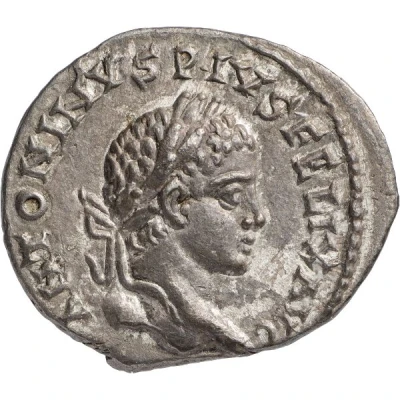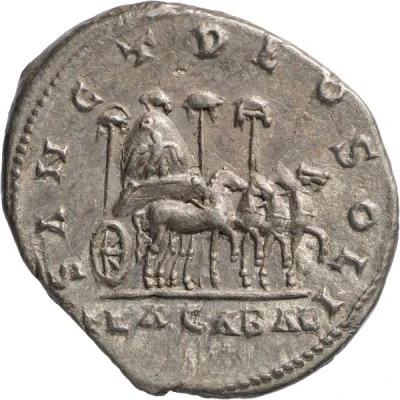


© Staatliche Münzsammlung München (CC BY-NC-SA 4.0 DE)
Denarius - Elagabalus SANCT DEO SOLI ELAGABAL; Sol Invictus
| Silver | 2.5 g | 19 mm |
| Issuer | Rome › Roman Empire (27 BC - 395 AD) |
|---|---|
| Emperor | Elagabalus (Sextus Varius Avitus Basianus) (218-222) |
| Type | Standard circulation coin |
| Years | 218-222 |
| Value | Denarius (½) |
| Currency | Antoninianus, Reform of Caracalla (AD 215 – 301) |
| Composition | Silver |
| Weight | 2.5 g |
| Diameter | 19 mm |
| Shape | Round (irregular) |
| Technique | Hammered |
| Demonetized | Yes |
| Updated | 2024-10-05 |
| Numista | N#276860 |
|---|---|
| Rarity index | 97% |
Reverse
Slow quadriga moving right, on which is set the conical stone of Emesa surmounted by eagle; in carriage, the stone is surrounded by four parasols.
Script: Latin
Lettering: SANCT DEO SOLI ELAGABAL
Translation:
Sanctur Deo Soli Elagabalus.
The holy sun god Elagabalus.
Comment
Mass varies: 2.06–2.8 g;Diameter varies: 18–20.2 mm;
Example of this type:
Staatliche Münzsammlung München
Source:
Online Coins of the Roman Empire (OCRE)
Interesting fact
One interesting fact about this coin is that it features an image of Sol Invictus, the Roman sun god, on the reverse side, which was a common motif in Roman coinage during the 3rd century AD. This suggests that the coin was issued during a time when the Roman Empire was promoting the cult of Sol Invictus, which was a religious movement that emphasized the power and divinity of the sun god. The coin's design may have been intended to promote the idea that the Roman emperor, Elagabalus, was a divine ruler who was blessed by the sun god and had the power to bring light and prosperity to the empire.